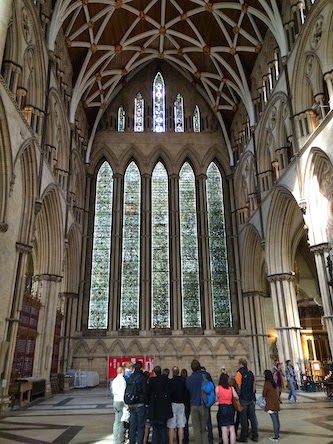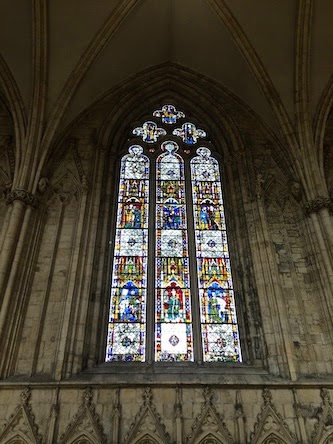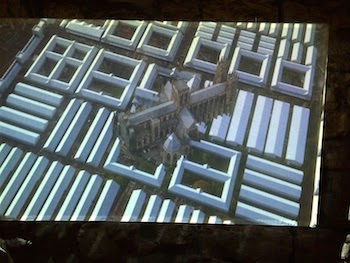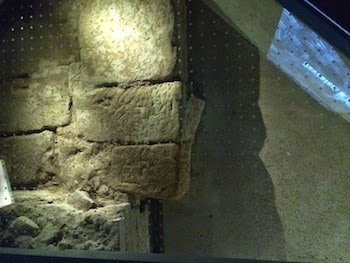 |
| A Transept Window at the York Minster |
I will admit that when Lori said we had to go to the York Minster Cathedral I was not overly excited. We’ve blogged about the “yet another cathedral” syndrome before, but after spending a few hours at the York Minster, I found the visit was more than worth the £10 admission, even for the most jaded of cathedral tourists.
The York Minster Cathedral is one of the largest churches in the world. Its layout is the classic cross of intersecting nave and transepts, and its style is thoroughly gothic. As opposed to Catholic cathedrals, the York Minster also has an ornate quire and adjacent chapter house. The windows at the four ends of the church are taller than tennis courts are long and are the oldest existing medieval stained glass windows in the world. In fact, the east end stained glass windows are being completely restored and we had the amazing opportunity to see the artistry of those windows up close: stay tuned for a couple of blogs where we’ll show you those windows in detail that you’ve likely never seen before.
 |
| The “Pilgrim’s Window” On The Minster’s Nave |
The York Minster is the working seat of the Archbishop of York, which exerts “metropolitical” control over the other dioceses of northern England. Its counterpart is the more famous Archdiocese of Canterbury to the south, and the history of the Minster is closely tied to centuries of rivalry between the two dioceses and the frequent animosity between their archbishops. With Canterbury enjoying proximity to the seat of English government in London, York has attempted to establish equivalent respect with this massive church. “Minster” refers to the church’s original designation as one of a missionary church.
Today’s Minster was built over a period of nearly 300 years and was completed in the late 1400’s. It was constructed around a previous Norman church–itself likely quite impressive–that had stood since some time before William The Conqueror arrived, as the Benedictine archbishop from York at the time traveled south to participate in the crowning of William as King of England. Even though the Minster was a Roman Catholic cathedral until the English Reformation, today it is a cathedral in the Church of England, and in fact William the Conqueror is memorialized (retroactively) with a statue in the Minster as the first head of the church in England (no pope statues are anywhere to be found, unsurprisingly).
Prior to the Norman church, stone and wood structures had stood on the site since the 600’s and were the site of coronations of a few Anglo-Saxon kings. And just a few hundred years before that, the Roman encampment of Eboracum stood as Rome’s northernmost outpost in the British Isles.
Several Roman emperors visited the area, beginning with no less than Julius Caesar, who didn’t see any great strategic advantage to the expenditures necessary to control the Isles. A century or so later, however, tin was discovered and the Isles suddenly became important. Several more Roman emperors visited as they tried to protect their holdings from the barbarian tribes to the north, including Constantius I, who died while in York. This isn’t particularly significant historically, except that his son–who had accompanied him to Britain to fight alongside him–was crowned emperor in (or near) the Roman basilica at Eboracum. That new emperor was Constantine the Great, who would soon legitimize Christianity for the empire.
The churches that would evolve into today’s York Minster were built on the site of the Roman fortress at Eboracum; this fact has been known for quite some time. But in the 1960’s, the massive central tower of the Minster was found to be in such a risk of collapse that emergency repairs were required. An excavation of the tower was made and huge concrete collars were built around the tower’s footings to shore it up. During the restoration project, archaeologists–working side by side with the construction engineers–discovered the original Roman ruins and determined that the center of the nave was built nearly directly on top of the original Roman basilica, the site where Constantine most likely would have been crowned as emperor of Rome.
 |
| A Rendering of the Minster Overlaid on the Ancient Roman Encampment, the Basilica In the Center |
 |
| The Outer Wall of the Roman Basilica, Directly Beneath the Minster’s Nave |
 |
| The Outer Wall of the Roman Basilica and a Drain, Still Drawing Water Away to the River Ouse |
 |
| Some of the Concrete Collars Built to Shore up the Minster Tower. Note the Bolts Securing the Collar to the Tower Footing. |
Also during the restoration process, the Minster constructed a museum of sorts, called the Undercroft, where other cathedrals might have a crypt. Amidst those giant concrete collars the church has placed a splendid collection of artifacts discovered during the excavation and from the church’s history. These include a tile discovered from the Roman era bearing the inscription of the Greek letters Chi-Rho, an early Christian symbol composed of the first 2 letters of “Christ”; this find seems to indicate that Christianity–perhaps secretly–came to Britain with the Roman legions. Also on display in the Undercroft is a 1000 year-old Book of Gospels, still used ceremoniously today for the installation of archbishops.
All of the history, the architecture, and the Undercroft of the York Minster make this cathedral, for us, one of the top 3 churches in Europe to visit.
 |
| 1,000 Year Old Book of Gospels, Open to (we believe) Matthew |






